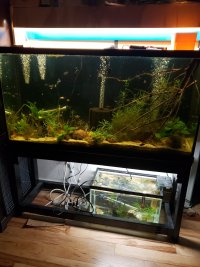Sanderguy777
Seedling
I've been reading through a few threads talking about water test kits and the science behind them. I honestly don't understand about half of what the "science types" say, though I think I get the general meaning.
I use test strips because they are easy, and the one time I used the api master kit, I'll admit, I returned it immediately. I'm NOT chemist material. Warnings about dissolving skin and cancer, and the fact that the tests took like 5 min per parameter, was enough to tell me that that was NOT a field I would enjoy!
Anyway, Darrel mentioned in the following thread that the "duckweed test" is a good alternative for test strips since the plant growth is based on what chemicals are in the water, and any algae that grows is because of some imbalance (generally, though I haven't heard of any accepted chemical cause of BBA).
 www.ukaps.org
www.ukaps.org
Does any plant that has access to the atmosphere work, or does it depend on the plant being specifically designed for floating and using atmospheric gasses for development? For instance, if I used a "floating" pogostemin stollatus octopus stem, will I get the same results as if I use a generally equal mass of salvinia or duckweed?
How does the conductivity of water affect plants and animals (I'm sure there is a doctoral dissertation in there somewhere, but I need a layman's breakdown of it. What chemicals cause it, how are they used by plants/fish/inverts, etc). What does it tell me about the aquarium?
I know this is a really big subject, that probably takes many classes and several degrees to cover in any detail, but I know it is valuable info, and I would like to understand WHY this and that work in the aquarium.
Hopefully, this can be of some help to someone down the line.
Thanks
I use test strips because they are easy, and the one time I used the api master kit, I'll admit, I returned it immediately. I'm NOT chemist material. Warnings about dissolving skin and cancer, and the fact that the tests took like 5 min per parameter, was enough to tell me that that was NOT a field I would enjoy!
Anyway, Darrel mentioned in the following thread that the "duckweed test" is a good alternative for test strips since the plant growth is based on what chemicals are in the water, and any algae that grows is because of some imbalance (generally, though I haven't heard of any accepted chemical cause of BBA).
Seneye vs Liquid Test Kits in a tank emergency
Yesterday was a major refurb day for my main tank, and I was expecting things to take a bit of time to settle down. However things have gone very odd, at least according the my seneye. Put simply the seneye has been reading a steady increase in ammonia since putting it back in the main tank (I...
 www.ukaps.org
www.ukaps.org
When you combine all these strands you get the "Duckweed index". You use the conductivity meter to give you a datum for your tank water, you have large gas exchange surfaces to constantly replenish/out gas gases and you use the health and colour of a floating plant (takes CO2 availability out of the equation) to estimate the nutrient status of your tank, and when nutrients need to be applied.
It isn't perfect but it works.
cheers Darrel
Does any plant that has access to the atmosphere work, or does it depend on the plant being specifically designed for floating and using atmospheric gasses for development? For instance, if I used a "floating" pogostemin stollatus octopus stem, will I get the same results as if I use a generally equal mass of salvinia or duckweed?
How does the conductivity of water affect plants and animals (I'm sure there is a doctoral dissertation in there somewhere, but I need a layman's breakdown of it. What chemicals cause it, how are they used by plants/fish/inverts, etc). What does it tell me about the aquarium?
I know this is a really big subject, that probably takes many classes and several degrees to cover in any detail, but I know it is valuable info, and I would like to understand WHY this and that work in the aquarium.
Hopefully, this can be of some help to someone down the line.
Thanks




